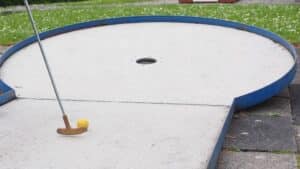Since you are reading this I presume you play golf. If that’s the case, it is quite likely that you have also played crazy golf, or mini golf. (More on that distinction in a moment.) The other day I was sent a link to the Junkyard Golf Club in Shoreditch, a trendy part of east London. The blurb read: “The craziest golf club in the world is in Shoreditch! Get ready to take a walk on the weird side, through four mashed-up 9-hole courses that will take you on a twisted journey.” I haven’t headed there yet but it certainly sounds unconventional. “Our bars are more like night clubs than golf clubs,” it added. “Grab one of our epic cocktails and come get weird with us.’ Sounds like one might get thrown out for wearing a V-neck sweater. I’m certainly figuring no one will be discussing the speed of the greens.
A few weekends ago the Financial Times ran a mega feature entitled ‘For the Love of Mini Golf’. The subhead read: ‘Just don’t call it Crazy Golf’. The story was built around coverage of the 2024 Seniors’ Minigolf World Championship, just outside Milan. Those Italians, hey – last year it was the Ryder Cup just outside Rome; now this! The former featured three different formats playing 18-hole matchplay golf over three days. This involved eight rounds of 18 holes in two days. But – and this is apparently the distinction between mini golf and crazy golf (or adventure golf, to give it an alternative moniker) – there were no windmills, clowns’ mouths or the like.
The fairways in mini golf will typically be curved so it’s not a completely straightforward task (an ability to assess angles is very helpful) but there is a metal rail to stop your ball leaving the course unless you have attempted something spectacularly rash. The terrain itself will be either concrete, felt or a cement-like compound. (Think hard-court tennis.) As for the ball, there are important decisions to be made here. They come in a range of sizes, weights, texture and hardness. The ambient temperature may affect your choice for a particular competition.
So-called fantasy obstacles (windmills, etc) are the norm in the UK whereas the continentals prefer the rather more austere version the competitors tackled in Italy. In the United States, they are – surprise, surprise! – even more OTT. Dinosaurs and pirate ships are special favourites. By a coincidence of timing given the recent piece in the FT, there was an interview in The Guardian on Saturday with Emily Gottfried, who has twice won the Women’s World Adventure Golf title and holds the British low-scoring record of 24 shots for 18 holes: 12 holes-in-one and six holes-in-two.
She and her husband are mad for the game; they have played over 1,000 such courses around the world. But “we’ve never been interested in ‘big golf’,” she said. “Not everyone wants to spend four hours out there.” However, they have ambitions regarding their own ideal of golf. “The World Minigolf Sport Federation (WMSF) is trying to get minigolf in the Olympics,” she said. “If it succeeds, we’d love to have a go. Winning an Olympic gold for crazy golf would be a dream come true for both of us.” Call it mini or crazy – who cares?
That may only be a pipedream, but I can tell you one thing. The WMSF already has anti-doping protocols, although I can’t see those catching on at Junkyard Golf.
You can follow Robert Green on Twitter @robrtgreen and enjoy his other blog f-factors.com as well as his golf archive on robertgreen-golf.com

